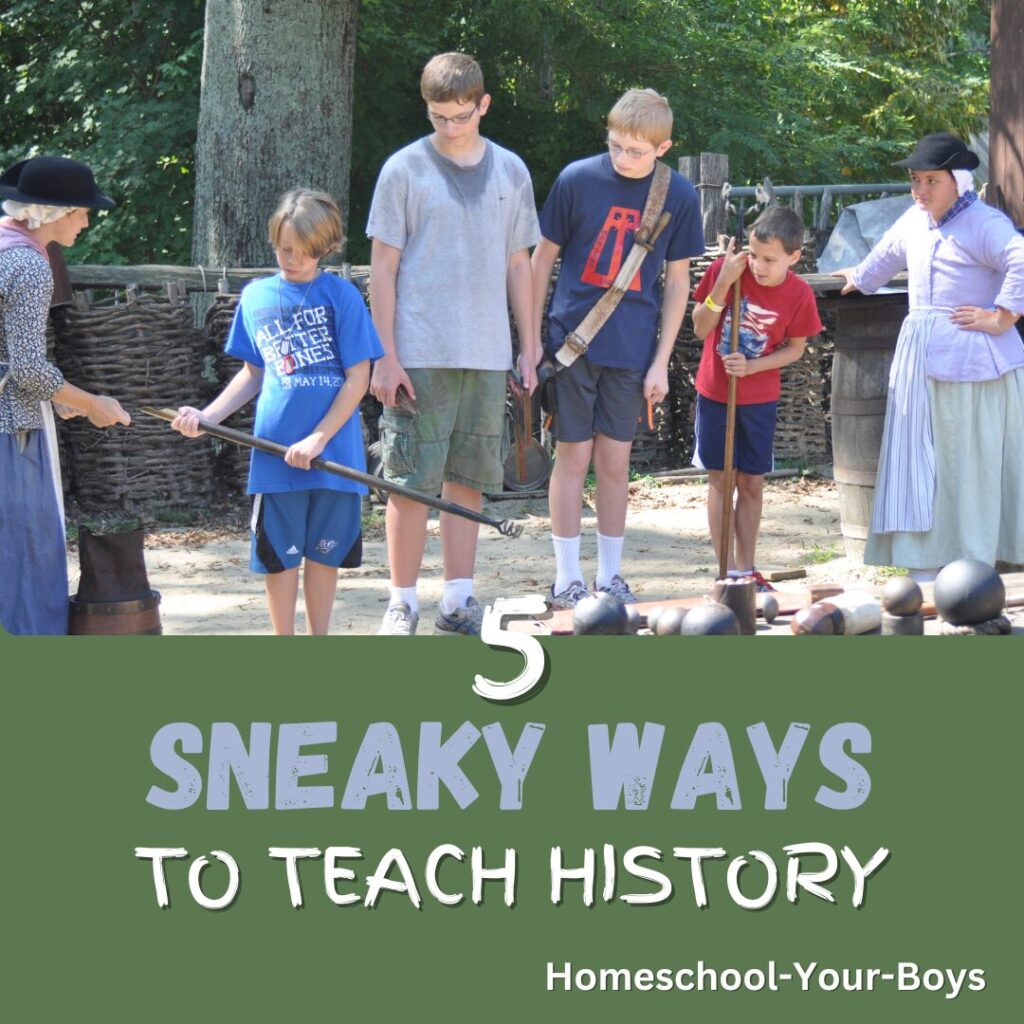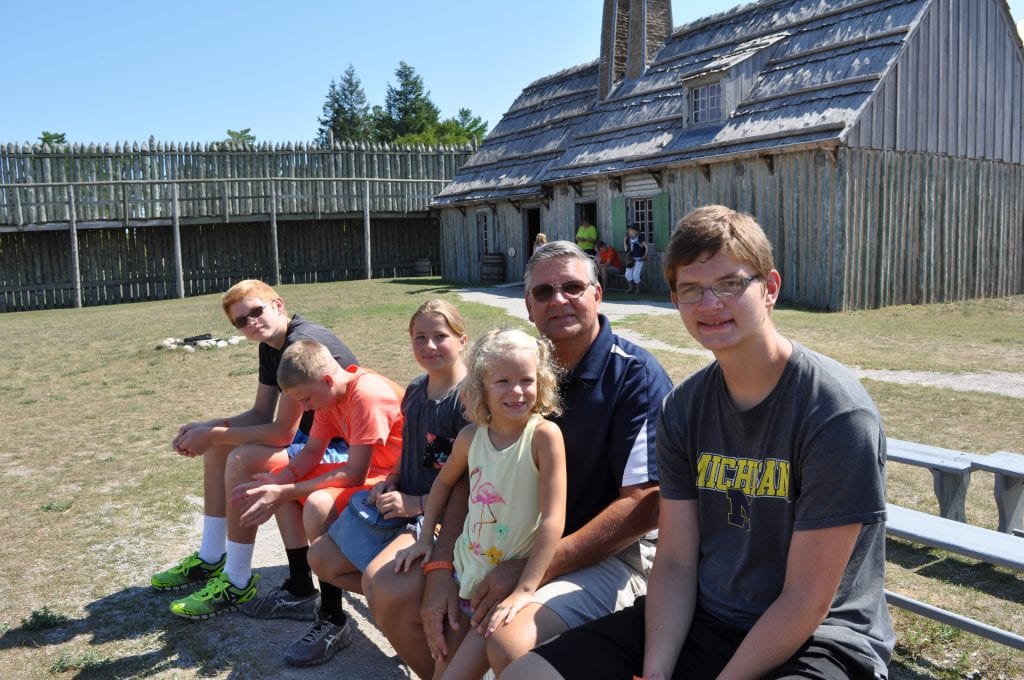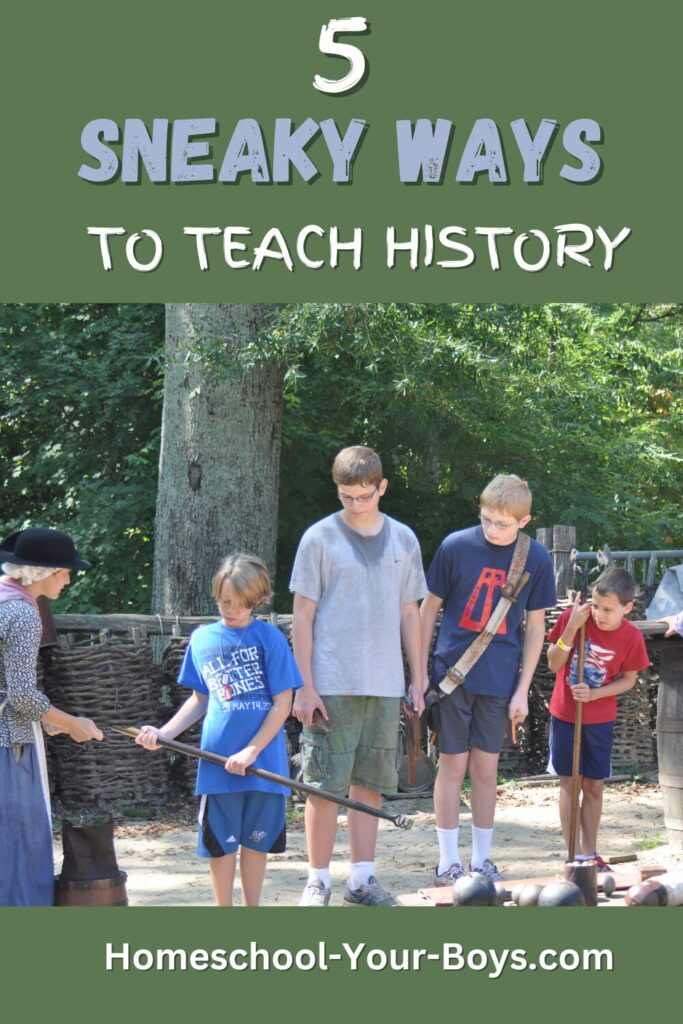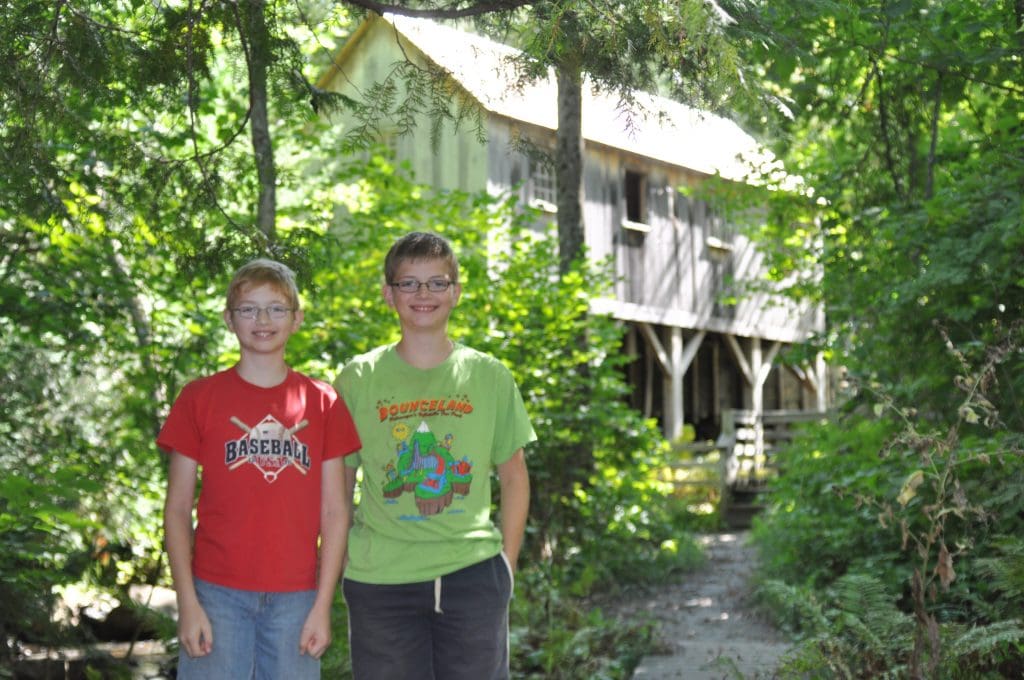Overview: The past isn’t boring if you teach history creatively. Turn this subject from a drag into a delight by capitalizing on these sneaky ways to teach history!
Do you hear moans and groans when you try to teach history to your kids? Or are they super excited when it’s time to tackle this subject? History is one of those subjects that can be a huge drag – or it can be the most interesting subject ever.
In fact, there are some sneaky ways that you can teach history to your kids and they will enjoy it so much they won’t even realize they’re learning!

Often, the reason kids dislike history is because of the way we try to teach it to them. Are you doing any of the following?
- Throwing a textbook down in front of them and having them do all of their learning by reading and taking tests
- Covering time certain time periods over and over while ignoring others
- Expecting your kids to learn lots of names and dates for a test
- Giving long writing assignments to make sure your kids have learned what you’ve covered
If you want your kids to enjoy studying history and you need some fresh ideas, try to sprinkle in some of these more subtle learning methods.
Here are 5 Sneaky Ways to Teach History Creatively:
There’s nothing magical about forcing kids to go through history in chronological order – especially when kids are older and they’ve been learning world history or American history for a while. If you’re sensing resistance with this subject, a great way to get your kids engaged again is to allow them to choose which time period you study.
A few years ago, I was planning to study American History from the American Revolution to the present. But my boys felt like they’d already learned a bunch about the Revolutionary and Civil War time periods.
So, they asked if they could study the WWI and WWII time period instead. They were also interested in learning more about the presidents from 1900 to the present.

So, that’s exactly what we did. I allowed them to dig in deep learning about that era and the modern day presidents for the entire year and they thoroughly enjoyed it. And, after listening to their suggestion, they were ready to learn about whatever time period I suggested the following year.
2 – Real Books
Some kids love to learn from textbooks. But my boys aren’t part of this group. I’ve found that reading real books and using more of a unit study approach has much more impact on my boys than does learning content from textbooks.
I like to use a variety of sources to get book ideas for various time periods/events:
- All Through the Ages by Christine Miller
- Beautiful Feet catalog book suggestions
- The Veritas Press catalog book suggestions (different grades study different time periods)
- Rainbow Resource catalog book suggestions (history by time period)
- American History Book by Time Period (for younger kids)
- Ancient History book suggestions
- And, of course, Google
The other thing that’s nice about using real books is that you can lean heavily on library resources. I look through one of the above book lists and find items that I can get from our library. There are usually plenty of options available.
If there’s a specific book that I really want and I’m unable to get it from the library, I then look on Amazon and eBay to see if I can buy it. It’s even better when a used copy is available!
→ Related Content: Teach Your Boys How to Enjoy Studying History3 – Field Trips
Field trips are another amazing way for your kids to learn history without them realizing they’re learning. I’ve actually had my boys try to argue with me that “This isn’t schoolwork, Mom!” when I take them to visit Fort Michilimackinac, or when we tour a Titanic Museum, or when we go to the local museum to view their King Tut exhibit, or when we went on a family vacation to Colonial Williamsburg. It cracks me up!
I love being able to sneak learning in when my boys least expect it. And as long as the subject matter is the least bit interesting to them, they’re also very willing to read about the displays and to try out the hands-on parts of the exhibits.
They enjoy listening to reenactors and we usually have some pretty great conversations on the way home about whatever they found most interesting.

4 – Movies
Our kids can learn from reading a book or listening to a lecture. But they have many other ways of learning as well. Try appealing to all of their senses. Boys, especially, are very visual.
If you pull out a movie about a historical period, they will enjoy it very much. Documentaries are also great ways for kids to learn history. There are all sorts of documentaries on YouTube, Amazon Prime, Netflix, etc. You may even be able to stream movies from your local library!
5 – Talk to an expert or someone who was there
If you’re learning about modern history, it’s wonderful to have them give your kids an eyewitness account of what they actually experienced. Nothing is more exciting than hearing about a skirmish or a war from a veteran.
And listening to grandparents tell about their experiences during the great depression is so much more interesting than merely reading about the facts in a book.
If you’re learning about ancient history, try to find a history buff, a re-enactor, a museum tour guide, a professor, or someone else who can paint your kids a vivid picture of what life was like during that time period.
Help history come alive for your kids! Learning history shouldn’t merely be an attempt to memorize a list of dates or a bunch of boring facts. It really should involve learning more about God working his plan through people to bring about redemption and about individual stories which are inspiring, informative, and will leave a lasting impression on our kids.
Try tweaking the teaching methods you use and watch the enthusiasm of your kids re-ignite!
How do you teach history? Have you discovered any tips that are working at your house? Please leave a comment below!



We much prefer history that’s learned through real life experiences. Great tips!
Thanks, Michelle. These methods definitely help history to come alive, don’t they?!? Thanks for stopping by!
Michelle, I love these suggestions! Some of our best history learning has happened when we’re (nearly) alone at a field trip site and a wonderful guide has taken the time to talk with the kids, tell them interesting things and answer all their questions. One of the perks of homeschooling!
Yes, that is a HUGE perk! It’s nice to be able to get that one-on-one time with guides rather than being lost in a huge, noisy group. So true!
These are all great ways to make history come alive for kids. I think field trips are the most fun, especially re-enactments of different time periods.
Re-enactments are amazing, aren’t they?!? We’ve been to civil war, revolutionary, and medieval re-enactments and they were all super fun. It’s fun to watch but it’s even better when they draw you in and allow you to participate!
We love using books and movies to teach history. Movies especially give a visual view of history in a way that nothing else can. For instance the images are very helpful when explaining what a carriage is to a 1st grader. 🙂
So true. “A picture speaks a thousand words” is an accurate statement for sure!
These are great ideas Michelle, thank you. At the beginning of the year we wanted to cover the Early Settlers and the Gold Rush here in NZ so while we were on vacation down in Central Otago, South Island we visited lots of old historical sites and musemns. The best part was finding old ruins that were part of my husband’s family history. Our boys thought that was just the best!
Fiona
Oh, that’s wonderful, Fiona. I’m a huge genealogy buff so that would be super special to me as well! How wonderful!!! I hope you took lots of pictures. 🙂
Great ideas! We love field trips and books. History really can be fascinating! Thanks!
It sure can!!! It’s important to delve into the fascinating stuff so that our kids will want to learn even more about it! We don’t want them to be doomed to repeat it.
Great ideas! thanks for the tips!
My children love love love Story of the World, we have been using that since the beginning. Every time I try to change it I get shot down. lol We also use field trips, books, and questions. Thankfully my hubby is a history buff as I am not. Thanks for these amazing resources!
Great article! I have been doing these things for years! My best reward was when our eldest was about to graduate and he told me all his favorite parts of how we home schooled. Then the topper… “Mom, I want to do it the same way with my children!”
Here’s a stealth way that I got science in to our sons and their friends, when they just “weren’t into science”. I planned an once a week science fun day! The group met at our house every Fri. I told them that I would NOT be grading anything, it was just for fun!! We ended up building a roller coaster and learning quite a bit about physics and engineering!! We covered other science topics and had a blast! No one ever misses a Friday Science Fun Day! At the end of our lesson or “fun time” I ordered some pizzas and let them hang out together!!! It totally worked. Had I actually been grading, each boy would’ve definitely made all A’s. Thinga like this and your ideas are what make home schooling such a blessing and reward!! Not to mention the bonding together and lasting memories!!!
Thanks so much for sharing that with us, Carrie. What a wonderful idea!!! Do you have any specific resources that worked well for your Science Fun Days or did they build stuff from scratch?